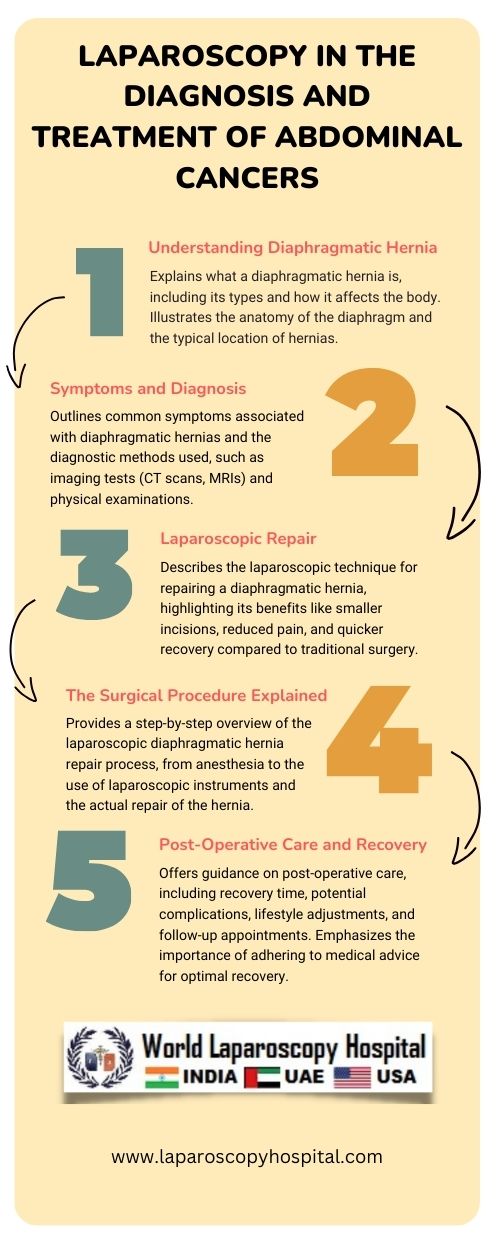Diaphragmatic hernia, a condition characterized by the abnormal protrusion of abdominal contents into the chest cavity through a defect in the diaphragm, poses significant health risks. Traditionally managed through open surgical methods, the advent of laparoscopic techniques has revolutionized the approach to diaphragmatic hernia repair. This article delves into the intricacies of laparoscopic diaphragmatic hernia repair, its advantages, procedure, and postoperative considerations, offering a comprehensive overview of this modern surgical marvel.

Understanding Diaphragmatic Hernias
The diaphragm, a large muscle separating the chest and abdominal cavities, is crucial for respiration. A diaphragmatic hernia occurs when there's a defect in this muscle, allowing organs like the stomach, intestines, or even the liver to move into the chest cavity. This can lead to respiratory distress and other complications due to the compression of the lungs and displacement of the heart.
The Laparoscopic Revolution
Laparoscopic surgery, also known as minimally invasive surgery, has transformed the landscape of surgical procedures. In the context of diaphragmatic hernia repair, this approach involves making small incisions in the abdomen through which a laparoscope (a thin tube with a camera and light) and surgical instruments are inserted.
Advantages of Laparoscopic Repair
1. Reduced Pain and Scarring: Due to smaller incisions, patients experience significantly less postoperative pain and have minimal scarring.
2. Shorter Hospital Stay: Patients often recover faster and can leave the hospital sooner compared to traditional open surgery.
3. Quicker Return to Normal Activities: The minimally invasive nature of the procedure allows patients to resume their daily activities more quickly.
4. Lower Risk of Infections: Smaller incisions reduce the risk of postoperative infections.
5. Improved Visualization: The laparoscope provides a magnified view of the internal organs, allowing for more precise surgery.
The Procedure
Laparoscopic diaphragmatic hernia repair typically follows these steps:
1. Anesthesia: General anesthesia is administered to ensure the patient is asleep and pain-free during the procedure.
2. Creating the Working Space: Small incisions are made in the abdomen. Carbon dioxide gas is used to inflate the abdomen to create a working space for the surgeon.
3. Insertion of Laparoscope and Instruments: The laparoscope and surgical instruments are inserted through the incisions.
4. Repairing the Hernia: The surgeon identifies the hernia and uses sutures or mesh to repair the defect in the diaphragm.
5. Closure: Once the repair is complete, the instruments are removed, and the incisions are closed with sutures or staples.
Postoperative Care and Recovery
Postoperative care is crucial for a successful recovery. It includes:
- Pain Management: Medications are prescribed to manage any discomfort.
- Respiratory Exercises: To prevent respiratory complications, patients are encouraged to perform breathing exercises.
- Diet and Activity: Gradual return to normal diet and light activities is recommended.
- Follow-up Visits: Regular follow-ups are necessary to monitor the healing process.
Risks and Considerations
While laparoscopic diaphragmatic hernia repair is generally safe, it's not devoid of risks. Complications can include infection, bleeding, injury to nearby organs, and recurrence of the hernia. Patient selection is crucial, and the procedure may not be suitable for all, especially those with extensive surgical histories or underlying health conditions.
The Future of Laparoscopic Diaphragmatic Hernia Repair
The future of laparoscopic diaphragmatic hernia repair looks promising with ongoing advancements in surgical techniques and technologies. Innovations like robotic-assisted laparoscopy are already making waves, offering even greater precision and control.
Conclusion:
Laparoscopic diaphragmatic hernia repair represents a significant advancement in surgical techniques, offering patients a safer, less painful, and quicker recovery option. As technology progresses, this approach will undoubtedly continue to evolve, further enhancing its efficacy and reducing associated risks, making it the gold standard for diaphragmatic hernia management.